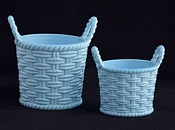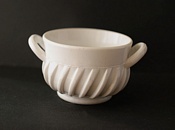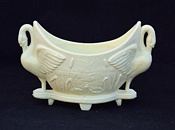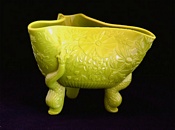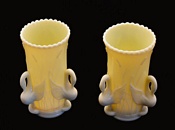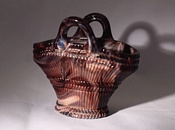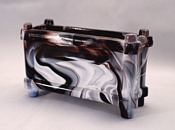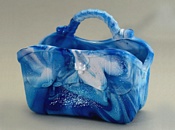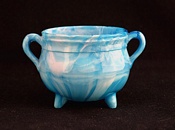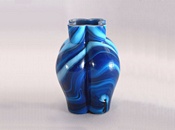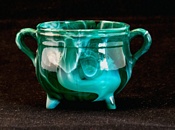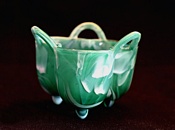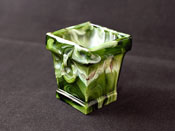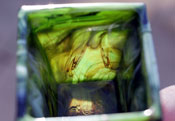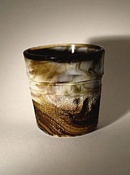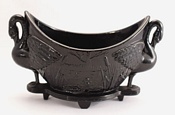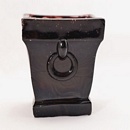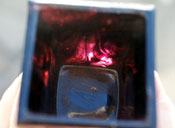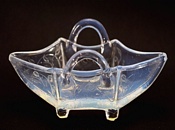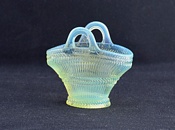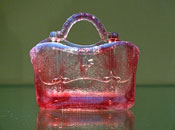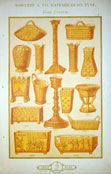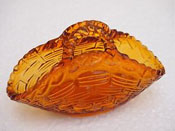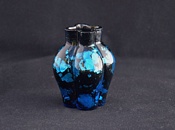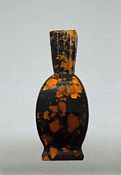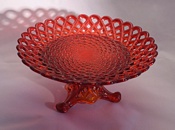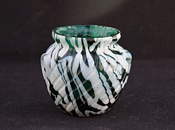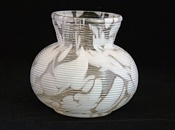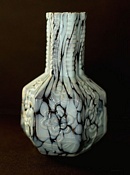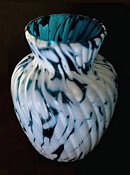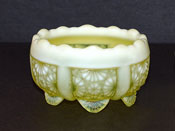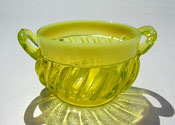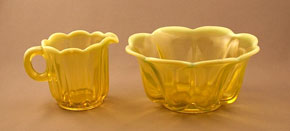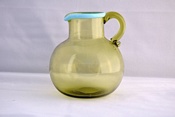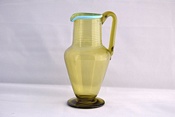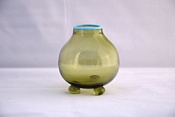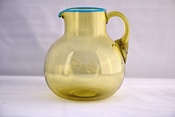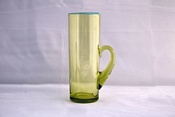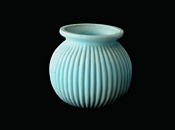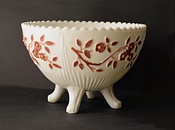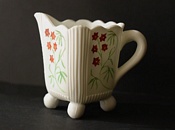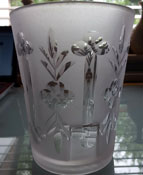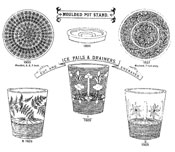Sowerby Pressed Glass Colours 1875-1885
An introduction to the coloured glass produced by the Sowerby company between 1875 and 1885 when John George Sowerby was managing the company, concentrating specifically on the glass colours used in pressed glass from this period. For research I have used the books in the BOOKS page on this site, I refer to the book by the author's surname and to which I reference where appropriate. I have also used pattern books, other articles and photographs of my own and museum collections where necessary. There are places where I have added my own ideas and conclusions, where I am unsure of something I will say so, everything is up for discussion.
Content
Pressed and Mould Blown glass
Pressed glass is the generic term for this type of glass. Although a lot of the items are mechanically 'pressed' by
the glassworkers, a number were also 'mould blown'. With mechanical 'pressing', molten glass is
introduced to the mould, then a plunger is pressed into the mould to produce the item. On pressed pieces the
plunger can also be machined to produce an internal design inside the piece being made.
A number of the patterns could only be mould blown, these are where the necks are narrower than the body and a plunger cannot be used.
These pieces are made by 'blowing' the glass into a mould, either by hand or by machine, the mould would then be opened and the piece cut off of the blowing rod.
When cold the glass 'rim' of the item would be ground off, which often results in chips to the top rim of the glass.
Items produced by this method are often not as 'crisp' as those produced by press moulding, not so much pressure is produced using the blow moulding method.
The factory mark, if present, is always on the bottom of these items and is frequently not very clear due the moulding method used.
On the other hand, blow moulding allows other techniques to be utilised such as on cased, nugget or marble glass, where 2 or 3 layers of glass or inclusions can be added by the
glass blower before being blown into the mould.
Looking through the pattern books you can see which items are made by which method.
The Sowerby Company
The Sowerby family had long been engaged in the glass industry in Newcastle before the invention of pressed glass. George Sowerby owned a glass works in Pipenwellgate, Gateshead in the early 1800s, followed by his son John as owner in 1844. In 1850 John went into partnership with Samuel Neville and together they leased land in East Street, Gateshead. As 'Sowerby and Neville', in 1864 they purchased the land outright. In 1871 John Sowerby's son John George Sowerby joined the company as manager and colour mixer. Later that year Neville left the company and in 1874 the company became Sowerby & Co.
John George Sowerby
John George Sowerby was born in 1850. The 1871 census shows him as a 'Glass Agent' so he was already working for the company when, again in 1871, he became a manager and colour-mixer. The Sowerby company was already making pressed glass and at this time was the largest manufacturer of pressed flint glass in the country. Under the management of JG, Sowerby's were responsible for many pressed glass innovations. In his first year with the company he registered a patent (number 2433. Sowerby, J. G. Sept. 15 1871) for a mould to produce an article with more than one colour of glass. JG was also a talented artist and produced many of the designs and designed many of the moulds for the company's most successful products in the 1870s and 1880s. He was also responsible for a new type of glass which appeared in 1877. The new glass was called 'Vitro-Porcelain', an opaque type of glass which resembled porcelain. Vitro-Porcelain was followed by various types of 'fancy' glass, these new types of glass were used to produce small decorative pieces in a variety of colours. By this time Sowerby's was the largest and most innovative pressed glass house in the world, with a large R&D department, constantly experimenting with new materials and methods. Vitro-Porcelain and fancy glass items would have been produced alongside Sowerby's main production of flint glass domestic goods.
Vitro-Porcelain Glass
In 1876 Sowerby's patented a type of coloured opaque glass which they called Vitro-Porcelain. Vitro-Porcelain was described as an opaque substance like glazed porcelain, and the colours were given the names of semi-precious stones, opal, jet, turquoise, malachite.
Vitro-Porcelain colours were the result of many months of painstaking experiments and were manufactured from very carefully controlled chemical mixes.
The Sowerby trade mark, a peacock's head, was registered on the 26th January 1876 and most Vitro-Porcelain can be found with this mark, usually accompanied with a design registration mark.
Opal an opaque white glass the first Vitro-Porcelain colour produced in 1876 followed by:
Turquoise a pale blue glass in the same year.
Jet a black glass was probably introduced at this time (see below).
Patent Ivory Queens Ware was patented in 1878 a colour 'in imitation of carved ivory'.
Malachite was also developed in 1878, a glass with a marbled and variegated effect.
Aesthetic Green pale lime green in colour was produced in 1881 followed in 1882 by:
Aesthetic Yellow also known as Giallo a pale yellow colour.
Malachite and Jet glass are discussed below.

Opal Glass Recipe
The Peacock and the Lions (scan from Pg 31) This is a copy of Sowerby's Opal formula found in the Sowerby records.
It shows that this Opal mix was used as the basis for Turquoise, with the addition of Copper (scale) and also for Queensware, with the addition of Uranium.
Queensware and Aesthetic yellow glass both fluoresce under UV light showing that the formula for Aesthetic Yellow also contains Uranium.
Malachite Glass
Malachite is a glass with a marbled and variegated effect.
It was produced in Purple, Blue (also known as Sorbini) and Green.
Sowerby mixed white 'Opal' with either blue, green, purple glass to produce Malachite.
It is confusing but the purple and white marbled glass which we all know, Sowerby called 'brown malachite'. We know this because page 3 of Pattern Book VIII 1880/1 is dedicated to 'Brown Malachite'. When photographing this glass it does frequently appear brown in colour.
All of the brown malachite pieces in my collection, when viewed with a strong light source behind, are completely opaque except one, which lets a little light through showing the base glass colour is a deep purple.
This deep purple colour is mixed with opal to produce the malachite marbling. Sometimes an opaque grey is seen in the marbling, this
is probably the natural result of mixing the purple and opal colours together. Translucent pieces do exist but these are rare and closely resemble Davidsons later produced Cloud glass.
A number of different hues of green and blue were used to produce green and blue malachite, hence the colours are quite variable, sometimes opaque, sometimes quite translucent, light or dark in colour, often with two or more shades of colour in the same item.
Sometimes it is quite difficult to tell if a piece is Green or Blue malachite as it is not obviously green or blue, but something in between.
One malachite piece shown below is an opal and fern green colour to which a small amount of purple/brown has been added, which can only be fully appreciated when held up to the light when it looks like Davidson's Cloud Glass.
There is a Brown malachite which is a real brown and white marbled glass. It is rare and I have only seen two examples, both are a trademarked Sowerby 'Just a thimble full' ornament.
Jet/Slag Black glass
Jet is a Vitro-Porcelain opaque glass, it is listed in pattern books VIII and XI but unlike Turquoise, Opal or the other colours I cannot find a date which shows when it was specifically introduced.
It is possible that Sowerby's were producing a black glass before Vitro-Porcelain was introduced but with an improved recipe an opaque glass was produced which they called Jet.
Slack (pg 40) 'In the early years of opaque glass, Sowerby's advertised along with the more popular colours such as Opal, Turquoise and Malachite, a glass called 'slag'. This was a type of glass which was black by reflected light,
and either a bottle-green or dark purple colour by transmitted light. As far as is ascertainable this was the only coloured glass that was termed 'slag glass', and it always appeared semi-opaque,being made in the same manner as cheap bottle glass.
It was short-lived and was superceded by a dense opaque glass which was advertised throughout the 1880s as Jet.'
All of the black pieces I have are opaque, you cannot see through them even with a bright light source behind, except one, a small square vase pattern number 1264 which is black but when held up to a bright light is actually a dark streaky purple in colour.
This could be a piece of 'slag glass', but it is also very similar to the colour used to make purple Malachite.
Cottle (pg 58) 'Sowerby's did not generally call their Vitro-Porcelain or coloured fancy glass by the term 'slag glass'. However, this may have referred to 'purple marble' or 'Jet glass'.
Yet both of these terms have been quoted separately when documented references to slag have appeared.'
So, the term 'Slag Glass' could possibly refer to purple malachite or black glass.
The only thing we can say with certainty is that if a piece of glass has a Sowerby mark, is black, opaque and with a good surface shine it is (probably) Jet vitro-Porcelain.
The glass items produced in Vitro-Porcelain proved very popular with their innovative shapes and colours, so popular that other glass houses such as Davidsons, Greener, and Edward Moore also began producing items in similar colours, malachite being especially popular.
Most of these Vitro-Porcelain colours are well known and some were produced in large numbers over several years.
Fancy Glass
The colours above are all opaque and can be termed as Vitro-Porcelain. The following colours can be described as 'Fancy'. In 1880 a new line called Blanc de Lait was produced which is a clear opalescent glass. In July 1882 Tortoiseshell glass was introduced and in the same year a 'red' transparent glass called rubine. In 1883 Gold and Blue Nugget glass was produced and about this time Marble Glass appears in advertisments.
Blanc-de-Lait Glass
Introduced in 1880, Blanc-de-Lait is a clear glass with a milky white opalescence. There is also a pale green 'vaseline' version of this glass which I believe may be the 'stained' Blanc de Lait referred to in advertisements at the time. (see paragraph relating to this below) The Shipley Art Gallery also has two Gladstone bags which are pink in colour with opalescence on their edges. (see note on this under Rubine Glass section)
Gold Glass
Gold is a translucent pale amber glass. A page of Gold glass is included in the 1880/1 pattern book VIII. Most of the pieces that are found are illustrated on this pattern book page which may suggest that this colour was not produced in great numbers.
This colour is also very similar to the amber colour used in tortoiseshell and gold nugget glass, see below.
Tortoiseshell Glass
Cottle (Pg 97) Reports on the glass at an exhibition in Manchester in October 1882 and Slack(Pg 40) 'In July 1882 a summer novelty was introduced under the name of Tortoiseshell Glass, and was reported as 'very pretty and attractive. It's imitation of the real shell is striking, and being brought out at a popular price it must have a large sale'. Tortoiseshell is also advertised on the front of the 1882 catalogue, and 'New Tortoiseshell and marble Vases' are also mentioned in a Pottery Gazette advertisment from 1882. (see below)
There is now a separate page for this type of glass HERE
Nugget Glass
Introduced circa 1883, and made in Gold and Blue, nugget glass is a mould blown glass with mica inclusions.
Nugget is a cased glass with typically, the pieces I have seen, an opaque black inner layer, then a layer of mica flakes then a thin outer layer of either translucent pale amber or blue to give the Gold or Blue Nugget effect.
As with all Sowerby mould blown pieces the top lip is ground flat and, if present, a Sowerby mark may be difficult to see.
Sowerby also seem to have made some pressed (rather than mould blown) items with mica flakes presumably made in a similar way to the Tortoiseshell glass as detailed above.
A pale blue example held by the Laing Art gallery is pictured with other examples of Nugget glass in Cottle (Pg 59).
Not many pieces of this type of glass have survived as it was only made for a few years, in a limited number of designs, and not in great numbers.
There is now a separate page for this type of glass HERE
Rubine Glass
Cottle (pg 60) 'a deep transparent red or Ruby glass was introduced towards the end of 1881'
In an advertisement in the Pottery Gazette and Glass Trades Review of October 1881, Sowerby advertised the availability of their superior ruby and green coloured pressed glass for ship-deck, side and mast-head lights, binnacle lamps, railway roof lamps and signal lenses.
Slack (pg 40) calls this deep red glass Rubine.
Lattimore (pg 52) In 1881 came a very deep red glass which they called rubine.
I have a problem with 'rubine'. I have not seen the name mentioned in catalogues. I have seen various marked and unmarked pieces in red but these are later patterns from at least the turn of the century, and in most cases probably a lot later.
Yes, there are red lattice plates with stands and a dolphin bowl in red, these are patterns from the 1880s but were updated and used probably up to the 1950s, they could have been made anytime until then.
Sowerby's made lamps for ships and trains in ruby red but I have not seen any pieces in the pattern books from the 1870/80s in pure ruby red.
Cottle (pg 61) 'a pinker version of ruby was later called Rubine and when added to a mixture of opal glass was called Rose Opalescent'
So now we have three colours, ruby, rubine and rose opalescent. The Pantone colour Rubine is a 'dark pink'. Sowerby used the term 'Blanc-de Lait' for his opalescent glass, not 'opalescent'.
So, for me, the opalescent Gladstone bags in the Shipley Art Gallery are either Rubine or Rose Opalescent. All other red pieces are ruby.
'New' Marble Glass
Referring to a pair of swan vases in Raymond Slack's collection, book and subsequent auction, Slack states:
Slack (pg 40) 'Another new colour appeared in the advertisments at about this time (1882) which closely resembled the Brown Malachite of earlier manufacture. This was called New Marble Glass'.
Slack (pg 41) Shows a B&W picture of one of the vases. 'New Marble Glass supersedes Brown Malachite and shows an amethyst hue'. Slack labelled this vase as 'New Marble Glass'.
Amethyst is purple in colour so these vases were presumably a purple glass marbled with Opal.
Green and Blue Malachite were produced using various shades and degrees of translucence of green and blue, so it is possible that the Brown Malachite vases that Slack labelled 'New Marble Glass' were simply Brown Malachite made from a different, possibly more translucent, mix of the purple base glass, not a new type of glass.
An advertisment in the Pottery Gazette of 1882 (see below) refers to "TORTOISESHELL, VITRO-PORCELAIN, MALACHITE, PATENT QUEEN'S WARE, NEW MARBLE GLASS, BLANC-DE-LAIT, AESTHETIC GREEN, ENAMELLED OPAQUE GALSS, STAINED BLANC-DE-LAIT, &c &c"
and later to 'NEW TORTOISESHELL AND MARBLE VASES'.
This can be read as 'New Marble Glass' or new 'Marble Glass'. I think this was a 'new' type of glass which Sowerby's called 'Marble Glass'.
As far as I know Sowerby's never referred to their malachite colours as 'marbled'. I believe that the term 'Marble Glass' on the cover of the pattern book refers to a mould blown, marbled and possibly cased glass which I have previously referred to as 'spatter' glass.
The glass has an opaque or translucent coloured, or clear glass layer onto which chips of another colour, usually Opal or Turqouise have been marvered and then blown into a mould.
The glass may also have a thin inner white casing.
See the images below:
Cottle (pg 56) also shows four items of this type of glass from the Laing Art Gallery, but there is no corresponding text to describe it.
Sowerby 'Pearline' Glass
In 1889 Davidson's patented a glass with a colouring which they called "Pearline". Pearline was mostly made in two colours, blue and a yellow which they called Primrose.
In this type of glass, parts, like the rim, when exposed to heat during the cooling process turn opaque leaving the rest of the body translucent.
It was a very successful product for Davidson's and continued in production until the outbreak of the First World War.
Greener's made glass in similar colours as did Burtles and Tate, a process used on their opalescent swans to good effect.
Davidson's Primrose is a yellow vaseline/uranium glass with opaque yellow top edges.
Sowerby produced a similar type of glass, which although bearing a Sowerby mark can be mistaken for Davidsons Primrose Pearline, although the intensity of the yellow glass is 'brighter' than that used in the Davidson version.
A small 2-handled dish, pattern 1254½, Sowerby Rd 314279 of 18 September 1877, and a small sugar and cream are known patterns produced in this colour.
It is not known when Sowerby produced these, or how many were produced, but the colour is rare. They could be contemporary with Davidson Pearline, produced using an old mould, or possibly Sowerby's were producing this type of glass a number of years earlier than Davidson's.
Venetian Glass
In around 1871 Sowerby's established an Art Glass Studio during a general revival of interest in Venetian style glass in Britain at that time.
Very little is known about the articles made by the studio, what is known is that somewhere between 1876 and 1877 Sowerby's introduced a 'trade' line in glass which they called 'Venetian'.
Sowerby Venetian glass is usually clear or pale green in colour with Turquoise glass usually being applied to the rim, as threaded decoration or prunts.
Sowerby Art Glass Studio
We know what Sowerby Venetian glass looks like as it appears on page 14 of the 1881 pattern book VIII.
Apart from a number of pieces donated to the Laing and Shipley Art Galleries by family members and friends of the Sowerby family, other glass from the studio is very difficult or impossible to attribute as the glass was never marked and did not appear in contemporary articles or photographs.
Very little is known about the Art Glass Studio but Cottle(pg 75) devotes a full chapter to Sowerby's Venetian and Studio glass. The last recorded mention of the studio glass was in 1885, it is probable that the studio was closed soon after this.
It is also possible that the studio was responsible for making some of the fancy glass outlined above. Nugget and Tortoiseshell glass especially were complicated to make, it was not merely a case of dropping glass into a mould and depressing a plunger, these items would have been produced by skilled glassmakers.
There is now a separate page for this type of glass HERE
Other Sowerby Colours and Surface Decoration
Vitro-Porcelain and 'fancy' glass were not the only colours produced at this time. Most of the output from the Sowerby factory was utility items produced in clear 'flint' glass. Items were also made in a whole range of, mainly translucent, colours. The Peacock and the Lions (scan of Pg 33) states that in the 1880s there were five different blue colours used and items from the pattern books can be found in a variety of colours. This page is also interesting as it shows the ingredients used to make other colours.
As well as colour, Sowerby used a number of surface decoration techniques.
Clear and coloured glass was treated to frost the surface. Baskets and nursery rhyme pieces are found with the raised surface decoration picked out in gold, silver or coloured enamels. These are cold painted and not fired onto the piece, often resulting in some of the paint missing from pieces. Blanc-de-Lait pieces have been found with the raised decoration 'stained' amber. After application the stain was fired to 'fix' it onto the surface of the glass. Other pieces have also been found with a very pale purple stain applied and fired onto the surface.
Cold painted enamel surface decoration is the effect often found and it is possible Sowerby used this technique to make some of the older designs more appealing to customers.
Pattern book XI 1885, which largely consists of flint glass items offers a number different surface decorations, Obscured, 'Plain and Obscured', 'Cut and Obscured', 'Plain and Envraved', Engraved, 'Cut Stars', Cut, 'Cut Hollows' and Frosted.
The outer surface on the ice bucket below has been sand blasted then finished with wheel cut decoration.
Pattern Books and Advertisements
A lot of information can be found in the Sowerby pattern books which would have been sent to wholesalers and retailers, and advertisements which appeared in trade publications at this time.
Four pattern books are available covering this period, part of book VII from 1878, book VIII from 1880, book IX from 1882. and book XI from 1885.
Pattern books VII, VIII and IX, were specifically for Vitro-Vorcelain and 'Fancy' glass, presumably these items were manufactured alongside their main production of flint glass domestic products.
There should also be another pattern book X dating between 1882 and 1885 but, so far, this has not been found.
A number of new designs were registered by Sowerby between 1876 and 1880, many for small decorative items and it is these which appear in the pattern books.
Designs from the pattern books are found in Vitro-Porcelain and 'fancy' glass, but items were also available in other 'common' colours such as green, puce and blue in various shades as well as clear flint glass.
A number of designs are also found that are not in the pattern books, these may be in books that have yet to be found or just not included.
The first few pages of pattern book IX show items that were in the previous pattern books and some of the more 'simple' designs, such as woven baskets which were probably produced when Vitro-Porcelain was first introduced.
Full versions of these pattern books can be found HERE
Book VII (1878)
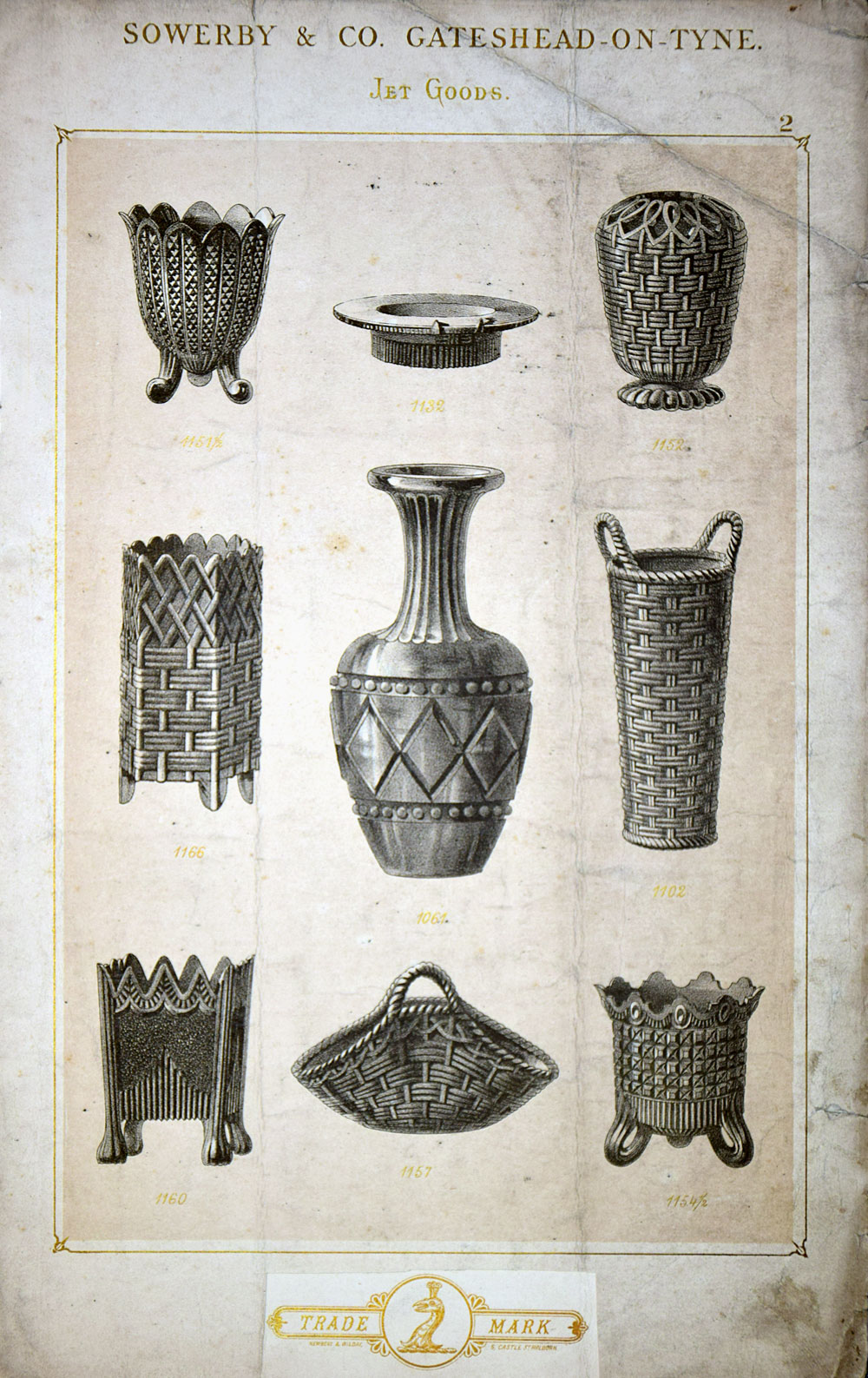
Just five colour pages survive from this book.
The first page is interesting as the patterns shown look to be photographs on a shiny paper, the page has been coloured with a translucent blue revealing a very good rendering of turquoise vitroporcelain.
This is the earliest pattern book known which features the new vitroporcelain glass.
Book VIII (1880)
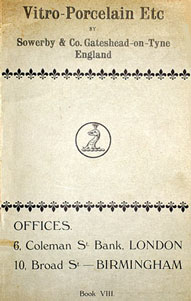
Vitro-Porcelain etc shows articles in Turquoise, Jet, Gold, Opal and three types of malachite Green, Blue and Brown.
Eight colour pages are also shown from this book.
The last page shows some of the blown glass Venetian ware made as a 'trade' line.
The cover also shows offices in London and Birmingham
Book IX (1882)
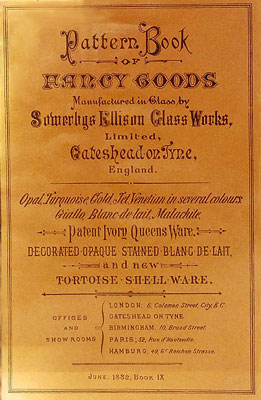
Pattern Book of Fancy Goods - this pattern books shows items from pattern book VIII plus a number of new items in 'aesthetic' form and decoration with each page heading showing 'Flint, Opal, Turquoise, Malachite, Patent Queen's Ware, Blanc de Lait'.
Opal, Turquoise, Gold, Jet, Giallo, Blanc-de-Lait, Malachite and Patent Ivory Queens Ware and Tortoiseshell are known colours
Venetian in Several Colours, although Murray (Pg 37) does refer to smoky brown glass items, the Venetian 'trade' line is only known in clear and translucent green colours with turquoise rims, trails or prunts. 'Venetian in Several Colours' may refer to the glass which was being produced in the Sowerby Art Glass studio at this time.
DECORATED-OPAQUE-STAINED-BLANC-DE-LAIT This line of the cover page is confusing and may refer to a number of different colours and techniques (see advertisement below).
Most of the patterns from book VIII 1881 appear in pattern book IX 1882. The 'simpler' patterns like the basket shapes listed at the front of the 1882 catalogue must have been made in numbers over the years, especially in Turquoise, Opal and Malachite as these are still to be found for sale quite frequently. Other items, especially those that appear towards the end of the catalogue are rarely found, so were probably made in far fewer numbers.
Book XI (1885)
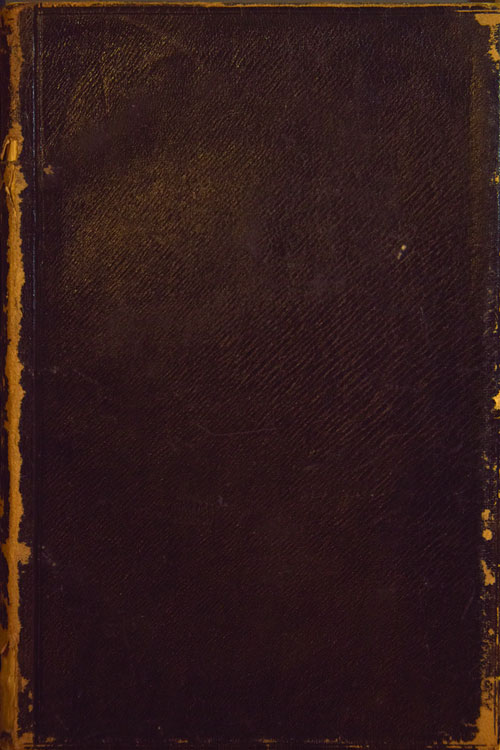
This large catalogue has eighty pages of mostly flint glass utility wares for domestic and commercial use rather than the mainly decorative items contained in previous pattern books. There is also a continuation of this catalogue containing a further thirty pages.
Some items from pattern books VII, VIII and IX have made it into pattern book XI, presumably the best selling ones.
An oyster dish, pattern 1615, on page 37 is specifically listed as being made in Turquoise, Opal, Blanc de Lait and Slag glass as are the Flint Flower Pots on page 32. A few items are listed as available in 'Plain, Bright and coloured glass'.
Pottery Gazette advertisment from 1st Novermber 1879.
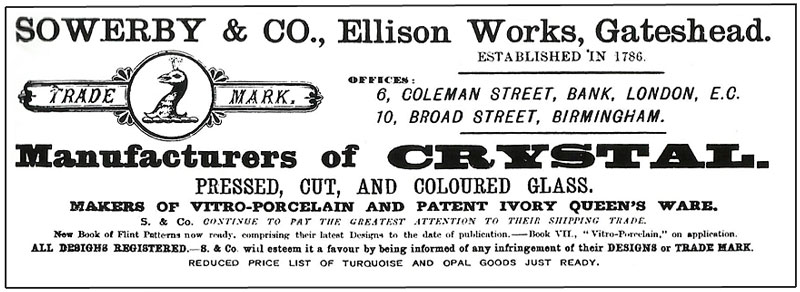
This shows that the bulk of Sowerby's products were still being made in clear glass but they are continuing to make vitro-porcelain products with a new pattern book, Book VII being available "on application". In 1880 new colours were being introduced and it may be that the first colours which were produced in vitroporcelain, Turquoise and Opal, were becoming less popular so are now being offered at a reduced price. It also seems that the popularity of their products is causing them to be copied by other companies, probably at home and overseas, hence the appeal for information on design and trade mark infringements.
This Pottery Gazette advertisment from 1882 makes more sense of the colours and decoration.
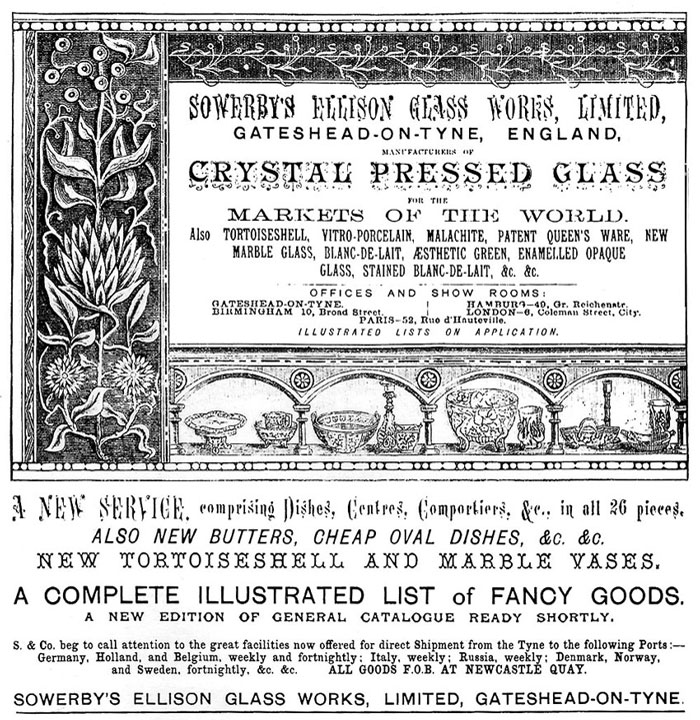
Most of the colours mentioned in the advertisement above have been discussed previously, the last two, Enamelled Opaque glass and Stained Blanc-de-Lait are discussed below.
Enamelled Opaque glass or Decorated Opaque
A small number of opaque vitro-porcelain baskets and nursery rhyme pieces were decorated by picking out the details in gold, silver or coloured enamels. These are cold painted onto the glass and not fixed by firing, because of this some of the paint is often missing from pieces.
Stained Blanc de Lait
see picture in Cottle (pg 60) - A few pieces of Blanc de Lait glass are found where the highlights have been picked out with an amber 'stain'. After staining the pieces were fired to 'fix' the finish onto the glass.
The late Bernard Cavalot, a well known British glass dealer, when refering to the above picture made the following observation - 'J.G. would not have considered enameling relevant to the colour of glass. Enameling, even fired-on enameling, was a
decorative process, nothing to do with glassmaking, as it could be used on pottery, china, and metal as well. So he would have regarded the group shown not as stained, as it says in the caption, but painted or decorated with enamel.'
I agree with this sentiment. While most Blanc de Lait items are opalescent clear glass, there are also a significant number found in a pale green opalescent glass which does not appear to have a specific name. I believe this colour could be the 'stained' Blanc de Lait referred to in the advertisment.
It is also possible the the 'stained' idiom may refer to the very rare pink tinted 'Blanc de Lait', referred to above as Rose Opalescent.
Vitro-Porcelain and Fancy Glass after 1885
When Vitro-Porcelain was first introduced in 1877, it was a new type of glass produced in interesting shapes and colours and sales must have been high.
New colours, Malachite, Queens Ivory Ware and Blanc-de-Lait kept the sales moving and also sold in numbers but, by 1880 sales of the original Vitro-Porcelain colours, Turquoise and Opal were on the wane, with advertisements listing prices as being reduced.
By 1882 even with the introduction of the new 'fancy' colours sales were probably not
doing well. The 'fancy' colours like Nugget, Tortoiseshell, and Marble Glass were
more difficult and time consuming to make so could not be produced quickly and cheaply
like the original Vitro-Porcelain colours. Because of this they were probably not commercially successful, were not produced in numbers and are rare today.
Cottle reports (pg 30) 'JG Sowerby resigned from the directorial board on the 29th November 1883. Relations were strained between him and his fellow directors but the reasons for this are not at all clear'.
While some of the earlier 'novelty' patterns appear in the 1885 trade
pattern book, and some patterns that are contemporary to this date can be found in coloured glass,
most of the items in the catalogue show the company were once again concentrating their production on flint glass domestic goods.
Perhaps at this point Sowerby's were failing to make novelty items pay. By 1885 the company seems to have mostly dropped Vitro-Porcelain and 'Fancy' glass items, they had also closed the Art Glass Studio, which had probably been setup by JG in 1871.
Mike Tomlin December 2024 Contact

